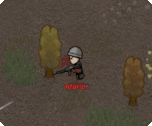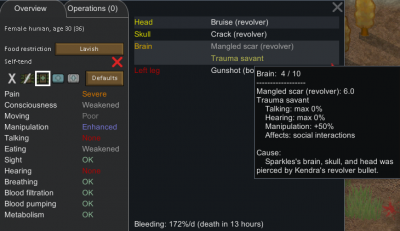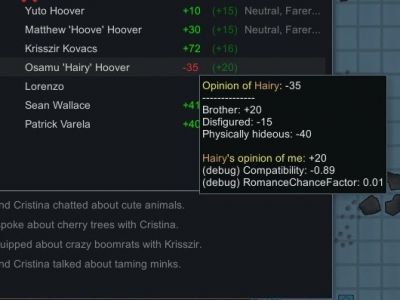Injury
|
Injuries are physical damage to a living being. Humanoids, animals, and mechanoids can sustain injuries from many sources, which each have their own Damage Type.
Injury types
Different weapons cause different types of injuries. For example, a mace will crush, a longsword will cut, and fire will burn. The type of injury impacts the amount of pain it causes, the rate of bleeding, and the chance of infection.
Summary
Injuries reduce a body part's health, its efficiency, and causes pain to the pawn.
Damage
Every body part has a health value, which is lowered every time it takes damage. When it reaches 0, the part is completely destroyed.
Any damage will lower a body part's efficiency, proportional to its health remaining. For example, if a arm has 15/30 health, then that arm performs 50% worse. As each arm is responsible for 50% Manipulation, this results in the pawn having -25% Manipulation until the injury is healed. Some parts, like the torso, are not responsible for any pawn stat, but still take damage and cause pain.
Some damage can be permanent. See Scarring for more details.
Pain
The greater the damage, the greater the pain. Pain is equal to pain = (damage) * damage_type_factor. Most injuries have a damage type factor of 1.25, or 1.25% pain per 1 HP damage. This is then scaled for the pawn's health, so a thrumbo feels less pain than a human for the same damage attack.
Pain reduces Consciousness directly, which reduces most pawn capabilities. It also gives a rapidly increasing mood penalty, unless the pawn is a masochist or follows an ideoligion![]() with the Pain: Idealized precept.
with the Pain: Idealized precept.
Excessive pain causes pain shock, the most common way to down pawns in combat, which prevents them from fighting. Most pawns have a Pain Shock Threshold of 80%. Note that enemies have a chance to immediately die when downed from pain shock, but not from other means, like blood loss or heat stroke.
Mechanoids are machines, and are immune to pain. In humans, pain can be completely eliminated with a painstopper, or reduced for a short time with go-juice or the Painblock psycast![]() .
.
Bleeding
| This section is a stub. You can help RimWorld Wiki by expanding it. Reason: How is blood loss rate calculated from damage?. |
Bleeding is a common occurrence from certain damage types. While an injury is bleeding, pawns will gain blood loss, scaling with the wound and amount of wounds. Total blood loss is listed under whole body, with a tooltip showing the percent. If blood loss reaches 100%, the pawn will die. Bleeding pawns will also leave blood on the ground, making the area dirty.
Bleeding always stops immediately with tending, regardless of the tend quality or medicine used. However, higher quality medicine can cover more wounds at once, which can stop a pawn from bleeding out faster. Injuries will also heal on their own, though a lost limb will always continue to bleed until tended to.
The coagulator ![]() implant halves the rate of blood loss, while the Superclotting gene
implant halves the rate of blood loss, while the Superclotting gene![]() rapidly stops bleeding. The ability added by the Coagulate gene
rapidly stops bleeding. The ability added by the Coagulate gene![]() gene also immediately tends all wounds on the target pawn, instantly stopping bleeding.
gene also immediately tends all wounds on the target pawn, instantly stopping bleeding.
Related
Infection
Infections can occur whenever a pawn is hurt by a bite, burn, frostbite, or any damage type that causes bleeding. A completely destroyed body part won't cause infection. Once a pawn recieves these injuries, the game starts a random timer between 15,000 ticks (4.17 mins) to 45,000 ticks (12.5 mins), per injury before checking for infection. The chance of infection depends on:
- Damage type. Bite, burn or frostbite wounds have a 25% chance, other bleeding wounds have a 10% to infect.
- Tend quality. The multiplier is 85% at 0% tend quality, linearly decreasing to 5% at 100% tend quality.
- Location. The higher the Cleanliness, the lower the chance for infection (50% at 0 Cleanliness).
Animals are 20% as likely to receive an infection. Mechanoids can't get diseases.
Scarring
| This section is a stub. You can help RimWorld Wiki by expanding it. Reason: Scar information (how the % chance for scar is determined). |
Scars are lasting markers of injuries. When an injury scars, it permanently lowers the health of the scarred body part, reducing its efficiency. They also cause a small amount of pain. The chance of scarring depends on damage type and the part being damaged. The eyes are particularly vulnerable to scars. Brain damage will always scar, and therefore always be permanent. In addition to injury, pawns may start with scars on them.
Scars can be healed by a limited number of ways. Artificial body parts never scar, and replacing an organic part will cure any scars. Luciferium and the Scarless gene![]() heal 1 scar every 15-30 days. A biosculpter pod
heal 1 scar every 15-30 days. A biosculpter pod![]() can do Bioregeneration, which costs
can do Bioregeneration, which costs ![]() 2 glitterworld medicine and takes time to complete. A healer mech serum can heal scars, but is very rare. A Creepjoiner
2 glitterworld medicine and takes time to complete. A healer mech serum can heal scars, but is very rare. A Creepjoiner![]() with the
with the ![]() Unnatural healing ability can also heal scars.
Unnatural healing ability can also heal scars.
Trauma savant
If a pawn receives physical damage to the brain, they have a 12% of receiving trauma savant. This ailment causes the following effects:
- A ×0% multiplier to Talking and Hearing, making the pawn unable to socialize.
- +50% to Manipulation, increasing effectiveness in many tasks
- Brain function is restored, as if it was not injured
Trauma savant can be cured with a healer mech serum. However, healer mech serum will always cure scars before trauma savant. As this ailment always occurs with a brain scar, you'll need multiple serums, or a serum with another way of curing scars (such as luciferium).
It can also be cured with a resurrector mech serum. If a pawn dies, and their corpse doesn't have a head or brain, then using a resurrector serum will restore usual brain function. With the Ideology DLC, you can use the 'extract skull' option to always remove a human corpse's head. In Core RimWorld, you can eat the corpse, though this risks eating the entire corpse.
Healing
| This section is a stub. You can help RimWorld Wiki by expanding it. Reason: Verification via C#, Preach health, Healing enhancer, with full math equation showing how the factors stack (both the different stats, which are likely multiplicative with each other, and the individual changes to those stats.. |
Injured colonists will recover from their wounds over time. Tending to a wound and resting in bed speeds up recovery.
Healing Rate
| This section is a stub. You can help RimWorld Wiki by expanding it. Reason: Other beds - royal bed, slab bed, dbl slab bed, ancient bed, crib. Don't trust pages, verify in code/game. Verify order of operations of genes and then example to include on row with a gene. |
Every 600 ticks (10 secs), heal rate × 0.01 points of damage are healed from a randomly selected (non-permanent) wound, or an average recovery of heal rate points of damage per in-game day (60,000 ticks). This healing reduces the severity of the injury, until the body part is fully recovered.
The exact heal rate is determined by adding up three factors:
- Default healing rate: All pawns have a base heal rate of 8, or 12 if they have a Healing enhancer installed.
- Is the pawn lying down or in a bed?:
- +4 for resting on a sleeping spot or the ground
- +8 for resting on a bed / double bed / bedroll / double bedroll
- +14 for resting on a hospital bed.
- Is the wound tended?: +4 for 0% tend quality and +0.08 per percentage of quality, up to +12 at 100% tend quality.
- Does the pawn have one of the following genes:

- ×50% with slow wound healing gene.

- ×200% with fast wound healing gene.

- ×400% with superfast wound healing gene.

- The effect of the genes is applied after everything else, allowing, together with the highest quality treatment, to achieve 34 * 400% = 136 regeneration per day.
- ×50% with slow wound healing gene.
Immunity Gain Speed has no impact on injury recovery; it only impacts diseases.
The wounds of pawns suffering from malnutrition will not heal.[Verify].
Example
To put this in perspective, consider a colonist who has taken 20hp of damage to various body parts, given different recovery scenarios:
- Do nothing: With no tending or rest, they get the base heal rate of 8, so it will take (20 × 60,000) / 8 = 150,000 ticks (2.5 in-game days) to fully heal.
- Basic tend and resting: With a 40% tend quality (+7.2) and rest in a non-hospital bed (+8), they'll have a heal rate of 8 + 7.2 + 8 = 23.2, so it will take 51,724 ticks to heal (approximately 21 in-game hours)
- Best quality care: With 100% tend quality (+12) and rest in a hospital bed (+14), they'll have a heal rate of 8 + 12 + 14 = 34, so it will take 35,294 ticks to heal (approximately 14 hours in game)
Medicine
Medicine does not directly cause healing, but it increases the average tend quality. Whenever a wound is tended, the quality is multiplied by the medicine given:
| Medicine | Potency |
|---|---|
| 0.30 | |
| 0.60 | |
| 1.00 | |
| 1.60 |
Each type of medicine has a cap on their tend quality; herbal medicine can reach a quality up to 70% in a regular bed, for instance.[Verify]
While bleeding wounds can be stopped by any quality of treatment, medicine can treat multiple small wounds in a single "batch" of tending. For patients with many bleeding wounds, the difference can easily be life or death.
Medicine is also useful for treating disease, where tend quality is more impactful, and performing surgery, which is boosted greatly by medicine.
Disfigured
Disfigurement is caused by damage or destruction to any beauty related part. These include the nose, eyes, ears, jaw, and, since version Version/1.3.3101, tongue. Destruction of the parent of any of the previously mentioned parts also cause this malus (ex: a missing jaw also counts as missing a tongue). It adds the "Disfigured −15" opinion modifier. Disfigurement can be treated by healing/replacing the injured/destroyed body part. Since Version/1.5.4062, replacing the parent part also removes this opinion penalty (ex: Dentures and Bionic jaws prevents the penalty from a missing tongue).
While disfigurement does not have a direct impact on a pawn's beauty, it does disable the positive opinion for positive beauty, while stacking with negative beauty.
Even while Disfigured, the opinion modifier won't apply to pawns that are either:
- Blind
- Kind
- Inhumanized

- Belongs to an ideoligion
 with the Blindsight meme AND the affected part is an eye.
with the Blindsight meme AND the affected part is an eye.
Trivia
Brain injuries in Rimworld cause large amounts of pain (20% or higher for a 5 hp wound), which can render a pawn permanently comatose in certain cases. This is a result of the reduction in Consciousness from the pain being added on top of the direct reduction in Consciousness from the brain injury itself due to the reduced part efficiency. However, in real life the human brain has no pain receptors. Despite their perceived location, headaches are usually caused by receptors triggering elsewhere in the head or neck, not by receptors in the brain. Certain types of headaches are due to irritation or swelling in the meninges, which is the membrane enveloping the brain and which does have pain receptors.


